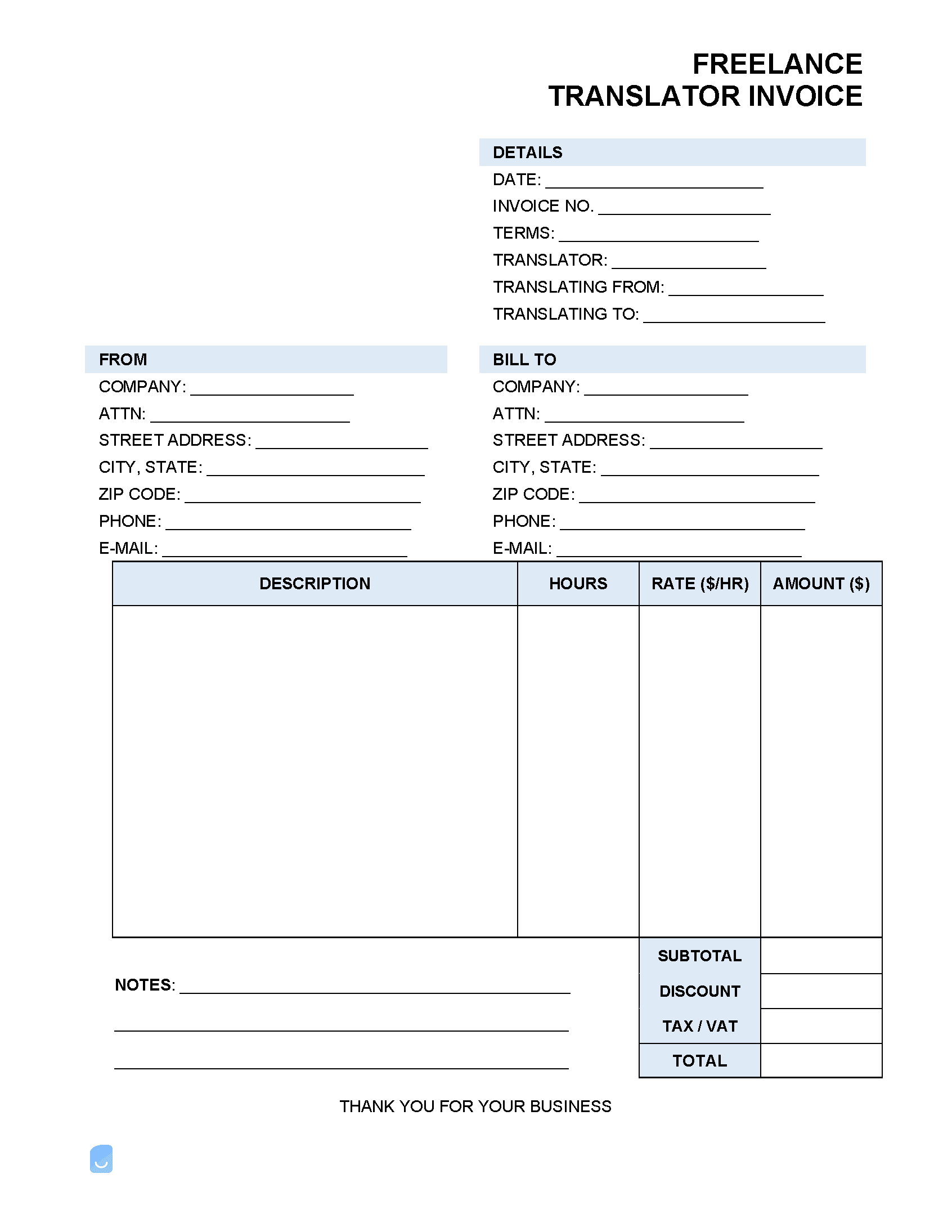Freelance Translator Invoice Template
A freelance translator invoice is a billing document used by individual contractors to request payment from a company or individual for the translation of a written text from one language to another. Translators typically charge on a per-word basis, with $.10 to $.20 per word being the standard in the industry.
How to Create an Invoice for Your Freelance Translation Services
A freelance translator invoice should include all details relevant to the translation project, including the name and contact information of the translator, as well as the name and contact information of the client and the number of hours worked. The translator should keep a copy of the invoice for their records. Another copy should be provided to the client who contracted the translation work as soon as the work is completed.
What is a Translator?
A freelance translator is an individual who is fluent in at least two (2) languages who understands each language’s cultural slang and subtleties well enough re-write text in another language. The best translators do all of this without writing in a way that makes it obvious to a native speaker that the language was re-written. In addition to being knowledgeable in foreign languages, many translators are fast typers, have experience in Microsoft Word, and know how to use programs such as CAD (computer-assisted translation) to ensure the proper translation of writing.
Translators vs. Interpreters
Translators and interpreters are often confused as the same profession due to their similar expertise and fluency in several languages. However, their differences lie in the fact that translators focus on written text, whereas interpreters focus on verbally translating between two languages in real-time. While their skills may be similar, the role of a translator is arguably slower-paced. It requires more accurate translation, where interpreters need more quick-thinking skills to translate spoken words within five (5) to ten (10) seconds of hearing them.
How to Become a Translator
To become a translator, first and foremost, an individual should focus on being able to fluently write (and speak) in a language other than their native language. Fully immersing oneself in a country or community where the studied language is spoken can offer significantly more real-world experience than books or classroom instruction can provide. This type of experience allows one to learn the social phrases and slang that wouldn’t be supplied in standard teaching. While professional education is not necessary, it can boost a translator’s resume and open up otherwise inaccessible positions within the federal government and other institutions. A typical major studied by translators is called “Language Interpretation and Translation,” which results in a standard four (4) year bachelor’s degree. As a mark of proving their skills and demonstrating their qualifications to employers, many translators opt for earning a certification through the American Translators Association (ATA). Those thinking of taking the test should know that passing it is no easy feat as the pass rate is just 20%. As an overview of the test, the following apply:
- Time length to complete: Three (3) hours
- Questions: Three (3) text passages
- Passing score: Pass / Fail. Scores averaged between multiple graders – a grading flowchart can be found here.
- Cost: $525
To prepare for the test, the ATA offers a practice exam. It costs $80 for members and $120 for non-members and is a non-timed exam that includes passages from the previous year’s test. Unlike the official exam, the answers on the practice test are returned to the student with all errors marked on the exam. This allows students to use it as a resource for learning and improving before registering for the certification exam.
Translator Salary & Hourly Rate ($/hr)
The income earned by those in the translation field varies according to the language being translated, the experience of the translator, and whether the professional is employed on their own, through a company, or by the government. According to the United States Bureau of Labor Statistics (BLS), the average yearly income and rates earned by both translators and interpreters are:
What to Charge as a Freelance Translator
There is no one answer to this question as each freelance translator will have their own way of determining their rates. Some factors that may influence a translator’s rates include the length and complexity of the project, the deadline, and the translator’s experience and expertise. Many translators charge by the word. Depending on the nature of the work, the rates fluctuate, but a good range is between .05 cents and .30 cents a word. Other translators charge by the page. Freelance translators just getting started can research what other freelance translators in their area are charging before determining a rate that takes into account their experience, fluency, and the speed with which they can complete projects.
How to Get More Freelance Translation Work
Here are some tips for finding more freelance translation work:
- Check out translator associations in your area. The American Translators Association can be a good place to start.
- Use LinkedIn.
- Conduct a Google search for translation agencies in your area.
What to Include in Your Freelance Translator Invoice
A typical freelance translator invoice includes the following line items:
- The name and contact information (e.g. email address, phone number, mailing address) of the translator
- The name and contact details of the client
- The date of the invoice
- Invoice number
- A description of the translation services provided
- The total amount due
- Applicable taxes
- The payment terms and accepted methods of payment (e.g. credit card, PayPal)
- The date of payment
